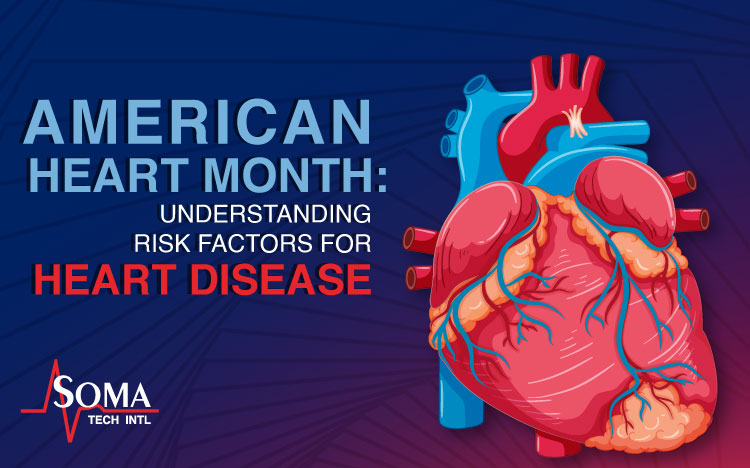American Heart Month: Understanding Risk Factors For Heart Disease
February 16, 2023
We often associate the month of February with hearts because of Valentine’s Day. However, there’s another reason we should think about hearts in February; it’s American Heart Month. February is designated as American Heart Month to advocate cardiovascular health and raise awareness about heart disease. American Heart Month is a wonderful opportunity to focus our attention on ways to promote and maintain heart health.
WHAT IS HEART DISEASE?
The phrases “heart disease” and “cardiovascular disease” are used interchangeably to describe the various conditions that affect your heart. Heart or cardiovascular diseases include blood vessel diseases, heart rhythm problems, and congenital heart defects. The most common form of heart disease in the United States is coronary artery disease (CAD), which occurs when the arteries that supply blood to the heart become hardened and narrowed due to a buildup of cholesterol, known as plaque. CAD can lead to health issues such as heart attack, heart failure, angina (chest pain), stroke, and irregular heartbeat.
FACTS ABOUT HEART DISEASE
Every year, one in four people will die from heart disease. Heart disease can strike anyone, but certain individuals may be more at risk than others. Some of the most common risk factors for heart disease include:
- High blood pressure
- High cholesterol
- Diabetes
- Obesity
- Poor diet
- Inactive lifestyle
- Cigarette smoking
- Excessive alcohol consumption
Heart disease is still the main source of death in the United States. In fact, cardiovascular disease remains the leading cause of death in the world. According to the Centers for Disease Control and Prevention (CDC), many of these deaths would have been preventable with proper preventative care.
KNOWING THE SYMPTOMS OF HEART DISEASE

While there are several different forms of heart disease, they share common symptoms and warning signs. It’s important to learn these symptoms to receive a prompt diagnosis and medical treatment. Symptoms of an emergency may include:
- Chest pain, discomfort, or uncomfortable pressure in the chest
- Shortness of breath
- Pain in the upper body, arms, back, neck, jaw, or upper stomach
- Feeling nauseous or vomiting
- Sweating; or cold sweats
- Weakness, light-headedness, feeling faint or dizzy
- Feeling very full or having indigestion
- Fatigue or exhaustion
- An irregular heartbeat, palpitations, or increased heart rate
INTERESTING FACTS ABOUT HEART HEALTH
Your heart does amazing things day in and day out. The main function of your heart is to keep oxygenated blood circulating throughout your body. Which is why it is vital to ensure a healthy heart. Here are some interesting facts about the heart.
- Your heart beats over 100,000 times per day.
- Your heart pumps about 1.5 gallons of blood every minute. For a day, that adds up to over 2,000 gallons.
- There are 60,000 miles of blood vessels in your body. That’s enough to go around the world twice.
- The average heartbeat of a woman is about 8 beats a minute faster than a man’s heartbeat.
- An adult heart is about the size of two hands clasped together. A child’s heart is about the size of a fist.
- Every cell in the human body gets blood from the heart except for the cornea.
- The right side of your heart pumps blood into your lungs. The left side of your heart pumps blood back through your body.
- The most number of heart attacks occur each year on Christmas Day. The day after Christmas and New Year’s Day are close behind.
- More heart attacks happen on a Monday than on any other day of the week.
- Heart disease is the greatest threat to your health. That’s why it’s important to be good to your heart by following a heart-healthy lifestyle.
HOW TO REDUCE HEART DISEASE RISKS?

To limit the risk of developing heart disease, consider making one, or several, of the below lifestyle changes.
- Move More: Get at least 2½ hours of physical activity each week—that’s just 30 minutes a day, 5 days a week. Can’t carve out a lot of time in your day? Try 5, 10, or 15 minutes a few times a day. Some physical activity is better than none.
- Eat Healthy Foods: A healthy diet that is low in sodium and saturated fat is key to heart disease prevention. Such as eating vegetables, fruits, whole grains, vegetable oils, fat-free or low-fat dairy products, and limiting foods with sugar and other sweeteners.
- Aim For A Healthy Weight: Being overweight is hard on your heart. It increases your risk of having heart disease, stroke, high cholesterol, high blood pressure, and diabetes. Choosing heart-healthy foods and getting regular exercise will help you achieve and maintain a healthy weight.
- Quit Smoking: The chemicals in tobacco smoke harm your heart and blood vessels in many ways. Quitting is hard, but many people have succeeded, and you can too.
- Reduce Stress And Improve Sleep: Stress can contribute to high blood pressure and other heart risks. Not getting enough sleep or regularly getting poor-quality sleep increases the risk of having high blood pressure, heart disease, and other medical conditions. Therefore, aim for 7–8 hours of sleep a night.
- Know Your Numbers: Meet your heart health goals by keeping track of how much you exercise, your blood pressure, and your cholesterol numbers—all of which can impact your heart health—and tell your doctor how you’re doing.
AMERICAN HEART MONTH
During American Heart Month, let us recommit to supporting the more than 120 million Americans living with a cardiovascular condition; advancing groundbreaking and lifesaving research; and expanding access to affordable health care, prescription medicine, and healthy lifestyles. Heart disease has long been the leading cause of death in the United States, claiming nearly 700,000 lives a year. But while heart conditions can be costly and deadly, they are also often preventable with access to affordable health care, advancements in technology, and lifestyle changes.
As treatments and access to care improve, we can each help to raise awareness of the importance of a healthy heart. Exercising regularly, eating well, managing weight, and avoiding smoking or vaping are proven to reduce the risk of cardiovascular disease. And we can save lives by each learning the warning signs of a heart attack or stroke and consulting a doctor if we have risk factors or symptoms
FINAL THOUGHT

Why do we observe American Heart Month every February? Well, every year more than 600,000 Americans die from heart disease. The number one cause of death for most groups, heart disease affects all ages, genders, and ethnicities. Risk factors include high cholesterol, high blood pressure, smoking, diabetes, and excessive alcohol use. Do you know how to keep your heart healthy? You can take an active role in reducing your risk for heart disease by eating a healthy diet, engaging in physical activity, and managing your cholesterol and blood pressure. It’s never too late to start living a healthy lifestyle and reducing your heart disease risks!
Explore Other Blog Items By Category
Recent Posts


EKG vs ECG | What’s the Difference Between ECG and EKG?


1 comment